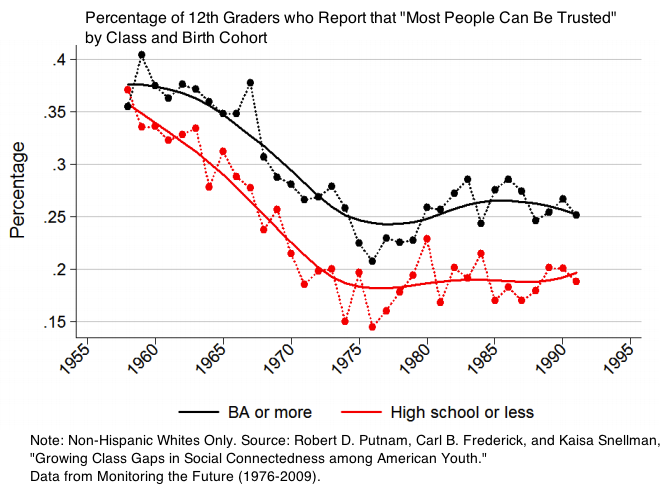Highlights
In a recent New York Times article, Robert Putnam tells the story of R, an 18-year-old white woman from his native Port Clinton, Ohio. R’s parents separated when she was in preschool, and her father hooked up with a woman who abused R, wouldn’t feed her, and confined her to her room with baby gates. Then, in high school, she spent time in a juvenile detention center for trafficking drugs. Today, she feels alone, like she can’t trust anyone. As Putnam says, “Her experiences left her with a deep-seated mistrust of anyone and everyone, embodied by the scars on her arms where a boyfriend injured her in the middle of the night.”
Putnam tells R’s story to illustrate how working class young adults are, “despite toil and talent, locked into troubled, even hopeless lives.” Drugs, crime, serial relationships, and mistrust, he finds, characterize their lives.
In the white paper “Growing Class Gaps in Social Connectedness among American Youth,” Putnam and his colleagues show that there is a trust gap between upper/middle class 12th graders and working class 12th graders:
The percentages of upper/middle and working class 12th graders who report that most people can be trusted declined steadily between the cohorts born in the late 1950s and those born around 1975. Beginning with the cohort of students born around 1980, the levels of generalized trust rebounded somewhat for upper/middle class youth, but not for their working class counterparts.

Putnam and his coauthors note that many of the working class youths who report low levels of trust live in neighborhoods with other working class Americans—areas in which the crime rate is higher, local government less effective, and life more stressful than in wealthier neighborhoods.
Mistrust is also a theme in Jen Silva’s new book, Coming Up Short: Working Class Adulthood in an Age of Uncertainty. In a New York Times essay, she quotes a working class 25-year-old man who says, “Trust is gone. The way people used to love is gone.” Silva also quotes Kelly, a 28-year-old line cook:
“I like the idea of being with someone,” she said, “but I have a hard time imagining trusting anybody with all of my personal stuff.” She said she would “rather be alone and fierce than be in a relationship and be milquetoast.”
Putnam and Silva’s descriptions resonate with what my wife, Amber, and I have been hearing in our own research with working class young adults. For instance, Amber and Brad Wilcox recently reported in National Review about another twentysomething Kelly that Amber interviewed. “I have a lot of trust issues,” this Kelly says. “I don’t trust men in general.” Kelly married her high-school sweetheart, but they separated after he slept with Kelly’s best friend. A couple guys later, she is ambivalent about marriage “because…you have to trust the person you’re going to marry,” and she’s not sure she can trust another guy.
‘Trust is gone. The way people used to love is gone.’
Clearly, there is something going on here. And there is a consensus emerging—from Charles Murray to David Brooks to Robert Putnam—that addressing the trust deficit in working class America, and America’s growing class divide, means shoring up our economic and family foundations. See also this recent State of Our Unions report from an ideologically diverse group of scholars, this Aspen Ideas Festival conversation between Murray and Putnam, and a Brookings Institution conversation including Andrew Cherlin, Ron Haskins, and yours truly. This developing consensus is just waiting for a bipartisan group of policymakers to leverage it.
That said, in order to understand the trust deficit, we have to understand not only who and what young Americans don’t trust, but also why working class youths especially are losing trust. The latter issue exposes deep philosophical differences between folks like Murray and Putnam—but (as I’ll suggest later) it also means crafting a policy agenda is only the tip of the iceberg.
In my next post, I’ll address why what Putnam describes as the “obvious” storyline—“vanishing jobs and economic insecurity for the bottom half of the U.S. labor force”—is not so obvious in the small Ohio town where I live.












